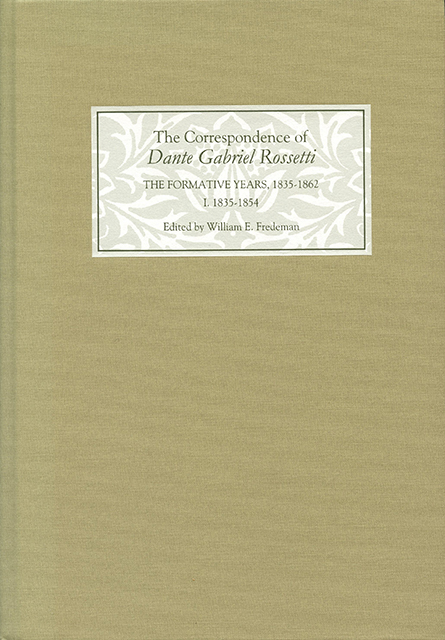 The Correspondence of Dante Gabriel Rossetti
The Correspondence of Dante Gabriel Rossetti Book contents
- Frontmatter
- Contents
- Dedication
- Acknowledgements
- Introduction: the Quest for Dante Gabriel Rossetti: Texts and Contexts in his Correspondence
- Editorial Statement, Editorial Principles, Description of Letter Entries and Stylistic Conventions
- List of Illustrations
- Abbreviations, including Manuscript and Major Printed Sources of Letter Texts
- The Letters 1835–1854: 1835–1847
Editorial Statement, Editorial Principles, Description of Letter Entries and Stylistic Conventions
Published online by Cambridge University Press: 25 March 2023
- Frontmatter
- Contents
- Dedication
- Acknowledgements
- Introduction: the Quest for Dante Gabriel Rossetti: Texts and Contexts in his Correspondence
- Editorial Statement, Editorial Principles, Description of Letter Entries and Stylistic Conventions
- List of Illustrations
- Abbreviations, including Manuscript and Major Printed Sources of Letter Texts
- The Letters 1835–1854: 1835–1847
Summary
Editorial Statement
In editing Rossetti’s letters, my first priority has been to generate an accurate, clear, uncluttered, and readable text that is totally faithful to the verbal, but not necessarily to every minute calligraphic symbol on the manuscripts. While I am sensitive to the arguments of G. Thomas Tanselle* and other textual critics who argue vigorously for quasi-facsimile typographical or diplomatic transcriptions that reflect with absolute fidelity every mark on the manuscript, I do not agree that verbatim and literatim texts are invariably the best or the only editorial models. The conventions of such editing, derived by analogy from the methods and techniques of textual criticism as these are applied to primary literary texts or from the abecedarian and mathematical formulae of descriptive bibliography, can produce letter-texts that are so complex as to overwhelm the content. The prescription to employ them, however, poses a crucial question about the status of literary letters: namely, whether they are to be regarded as an inherent part of an author’s canon or as personal biographical and historical documents. If a writer’s letters are construed as literary texts, as in some instances they may well be, then the editor has virtually no flexibility in the standardization and regularization of punctuation, spelling, capitalization, abbreviations, titles, salutations and closes, and even matters of spatial format, such as the placement of addresses, dates, postscripts, endorsements, illustrations, and other notations on the manuscripts. Whether, even then, the dogma applies equally to all the calligraphic incidentals and accidentals – substantive matters are not in question – is, in my view, open to debate.
In Rossetti’s case, his letters are revealing as life documents, characterizing the man, the poet, and the artist, but they cannot, in my opinion, be construed as “creative” in the literary sense, notwithstanding that they do contain dozens of examples of fine writing. As a consequence, in editing them I have striven first for accuracy, readability, clarity, and consistency. Fortunately, Rossetti’s hand is in most instances perfectly clear – indeed, one commentator described his calligraphy as the most beautiful among English writers – so there are few transcriptional problems affecting the substantive content of the letters. While Rossetti is normally an impeccable speller, he is thoroughly inconsistent in his handling of titles, both of literary and of artistic works, which may appear in the same letter within quotes, underlined, or unmarked.
- Type
- Chapter
- Information
- The Correspondence of Dante Gabriel RossettiThe Formative Years, 1835-1862: Charlotte Street to Cheyne Walk. I. 1835-1854, pp. xxxv - xliPublisher: Boydell & BrewerPrint publication year: 2002


